Transparent communication in the workplace is not about indiscriminately spilling every detail or risking organizational exposure — it’s a strategic choice.
You share relevant and appropriate information with the people who need to hear it.
When leaders communicate with transparency and clarity, they cultivate trust, retain talent, and avoid costly workplace miscommunication.
Employees aren’t kept in the dark, wondering what’s coming next — instead, they understand how and why decisions are made, and how their role contributes to the bigger picture.
Rather than being a risk, transparency becomes a tool for better productivity, reduced organizational costs, and happier employees.
In this post, we’ll talk about:
- What transparent communication in the workplace is,
- The benefits of transparent communication, and
- How to build a transparent culture.
Let’s start.

- Transparent communication means openly and timely sharing relevant information with the relevant people.
- Transparency in the workplace leads to more productive, satisfied employees and better retention.
- A lack of transparency in workplace communication leads to big financial losses for businesses and poor employee experience.
- Transparent communication in the workplace is harder to achieve without the right tools.
Table of Contents
What is transparent communication and the importance of transparency in business
Transparent communication is a type of communication where both positive and negative information is shared upward, downward, and in a lateral manner, according to the definition provided by Michigan State University.
In other words, transparent communication in the workplace means openly and timely sharing accurate and relevant information about any decisions, actions, and outcomes with the people who need to hear it.
Transparency ensures that employees understand the “why” behind organizational decisions, reducing confusion and building trust between teams and leadership.
Enable transparent communication with Pumble
The importance of transparency in business communication
Underdeveloped communication skills, especially when it comes to transparency, have detrimental effects on businesses.
Most notably, the lack of transparency costs companies staggering amounts of money each year.
According to Axios HQ’s 2025 internal communications report, employees earning $50,000–$100,000 lose 35+ working days per year due to ineffective communication — that’s equivalent to over $10,000 lost per person annually.
For higher earners, ineffective communication leads to $30,000+ lost per employee each year.
On a macro scale, miscommunication in the workplace is estimated to cost the US economy $1.2 trillion annually.
Furthermore, workplace communication issues cause a significant amount of personal employee consequences, with 43% of employees reporting stress, fatigue, and burnout.
But transparency isn’t just about avoiding costs — it delivers massive returns. Here are some of the benefits of transparent communication:
- 64% of leaders believe that nurturing effective and transparent communication leads to higher productivity.
- Transparent communication boosts employee morale. In fact, it’s linked to much higher rates of job satisfaction — employees in transparent workplaces report 6x higher job satisfaction compared to those where communication is poor.
- Companies that foster effective communication are 4.5 times more likely to retain talent.
Transparent communication is a skill that leaders and teams must practice daily — choosing clarity over comfort and consistency over convenience.
The data makes it clear that the payoff is worth the effort it takes to adopt this mindset shift — seeing openness and transparency not as a risk, but as an effective way to build trust, alignment, and lasting results.
💡 Pumble Pro Tip
Transparent communication is one of the ways you can boost employee engagement and morale. For more ideas on how to boost employee morale, check out our blog post:
10 Actionable strategies to build a culture of transparency
Transparency is undoubtedly an essential part of healthy and productive organizational communication.
However, it’s not always easy to implement.
We’ve compiled a list of actionable and practical strategies to help you implement transparent communication and build a transparent and positive company culture.
#1 Default to open channels of communication
Transparency starts with a default open setting.
Whenever possible, you should choose public or shared channels of communication instead of private ones. Use group chats, shared documents, or group meetings so that updates and decisions are visible to everyone.
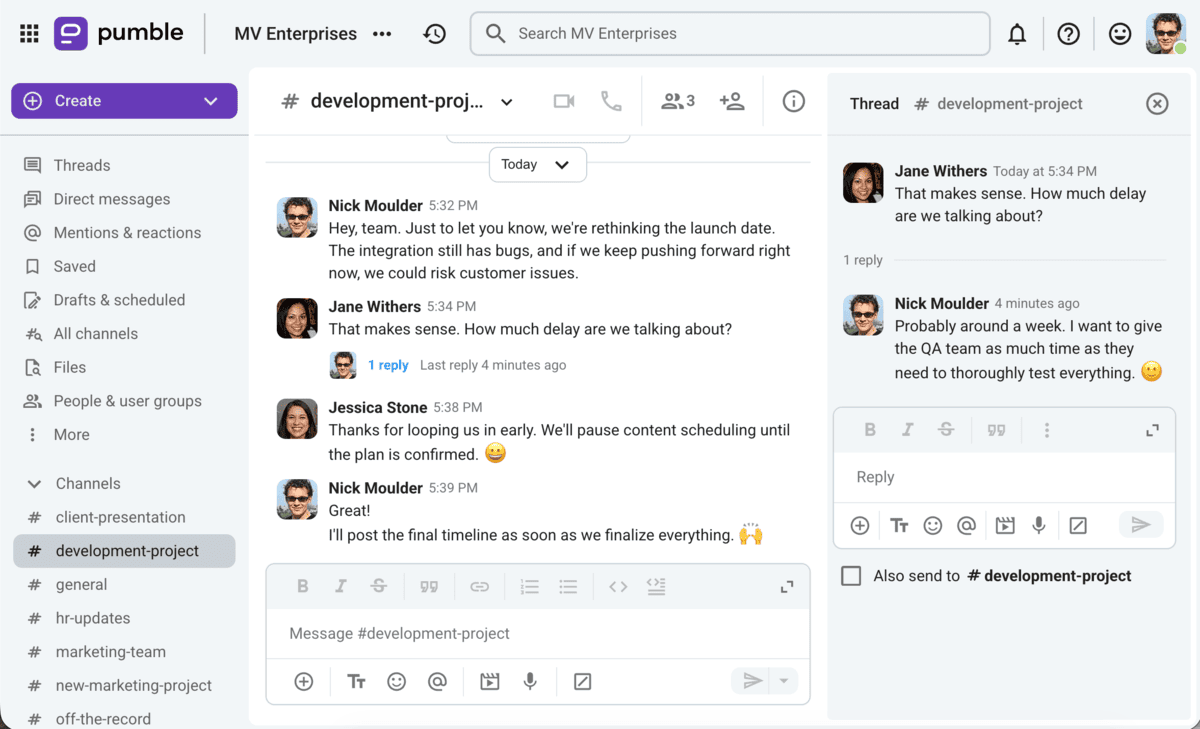
The goal isn’t to overcommunicate with redundant information, but to make sure valuable information isn’t hidden in private conversations or inaccessible to the people who need it.
When discussions happen behind closed doors, even unintentionally, people start filling in the blanks with assumptions. Over time, this erodes trust.
An open-door mindset, both physically and digitally, will signal to your team that transparency is welcomed and wanted.
Create open channels of communication with Pumble
#2 Set an example as the leader
Transparency has to start at the top.
If leaders don’t model transparent executive communication, no one else will believe it’s safe to be open and transparent.
That means:
- Explaining decisions honestly,
- Admitting when you don’t have all the answers, and
- Being consistent between what you say and what you do.
When leaders share context instead of just directives, they show respect and trust in their employees.
Setting an example also means rewarding transparency in others.
As a leader, you should acknowledge and reward when team members:
- Raise a tough issue,
- Provide direct feedback, or
- Share struggles.
Over time, this consistency will build psychological safety.
Team members will stop adjusting messages to what management wants to hear and start telling the truth.
A transparent company culture grows from leadership transparency, not policies — if you want openness across the organization, it starts with you.
Model transparent leadership with Pumble
#3 Communicate the why, not just the what
Most communication fails not because of what is said, but what’s left out.
When you share a decision or update without context, it feels like a command. When you take time to explain why something is happening — why priorities shifted, why a process changed, why a goal matters — you help your team connect their work to a larger purpose.
Even bad news lands better when people understand the reasoning behind it — they may not like it, but they’ll respect the honesty.
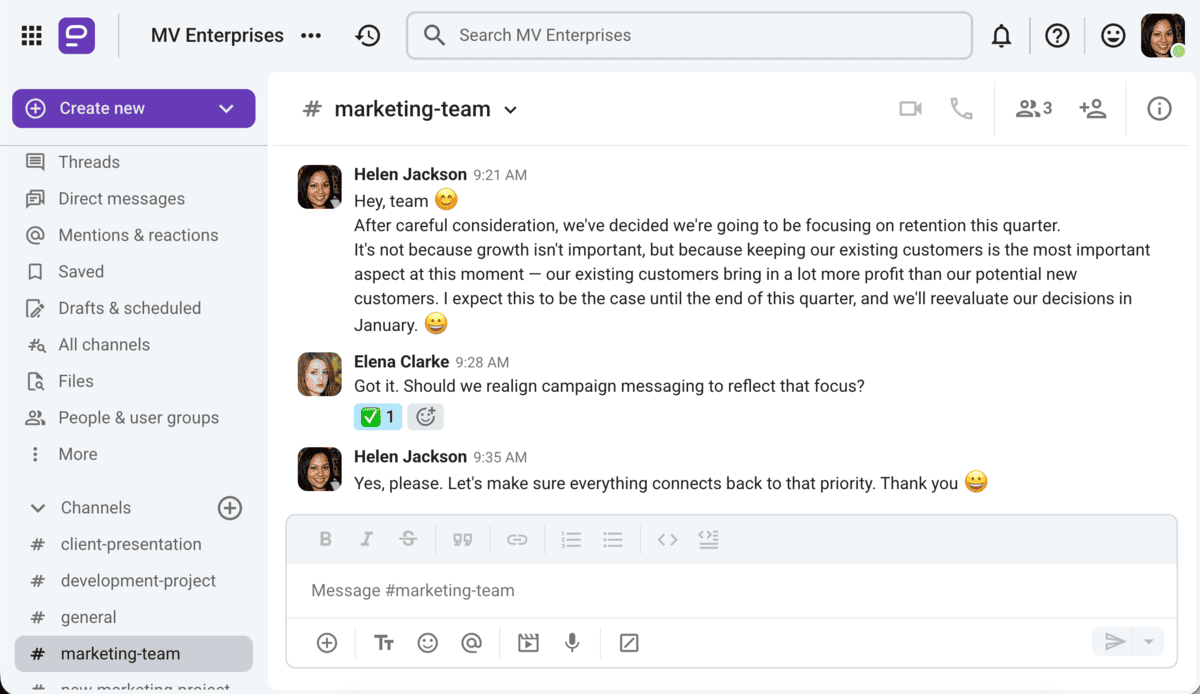
When you explain the reasoning behind decisions, it also:
- Prevents rumors,
- Curbs grapevine communication,
- Reduces resistance to change, and
- Saves hours of rework caused by misunderstandings.
Transparency means respecting people enough to explain your thinking, not just relay your decisions.
💡 Pumble Pro Tip
Transparency is key in maintaining effective group communication. To learn more about how to support healthy and effective group communication, read our blog post:
#4 Explain why you can’t share what you can’t share
Transparency doesn’t mean you’re obligated to share everything.
There will sometimes be information that can’t be shared — pending decisions, personnel issues, sensitive financial information, etc.
The key to staying transparent in these types of situations is to acknowledge your limits.
It’s better to say: “I can’t share details right now because they’re confidential, but I’ll update you as soon as I can.”, rather than staying silent.
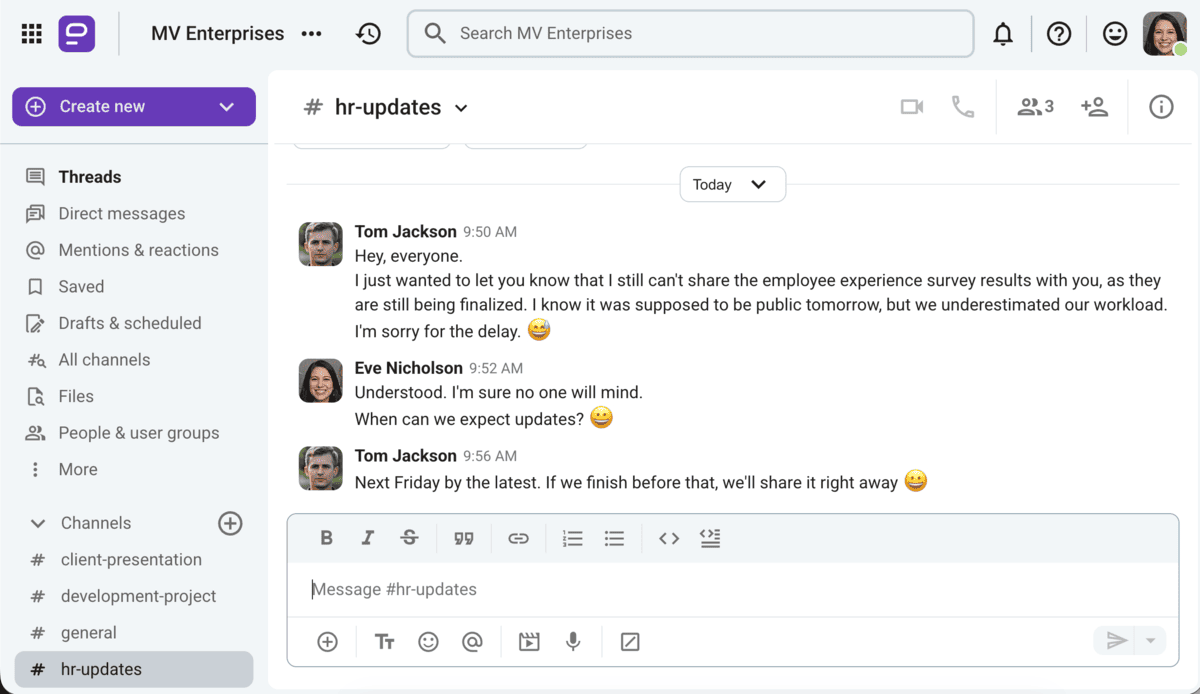
When you leave gaps unexplained, people assume the worst, but when you explain why a gap exists, you preserve trust.
Paradoxically, admitting you can’t be open about certain information will show your commitment to transparency.
#5 Admit mistakes and share learnings
You can’t claim to be transparent in your communication if you only ever share good news.
Admitting mistakes shows credibility, not weakness. When you, as a leader, own errors openly, you create an environment where accountability feels safe.
This transparency prevents small issues from turning into crises, and shows that progress is more important than perfection.
The key is to follow up after every mistake and share what you’ve learned — what went wrong, what will be done differently, and how others can avoid the same pitfalls.
Sharing learnings makes failures productive.
#6 Create clear feedback loops
Transparent communication depends on more than just announcements — it needs to be a consistent back-and-forth.
Clear feedback loops ensure that information doesn’t just flow downward, but both ways.
Encourage employees to share what’s working, what’s unclear, and what’s blocking their progress. Then, close the loop — acknowledge the feedback, act on it when you can, and explain when you can’t.
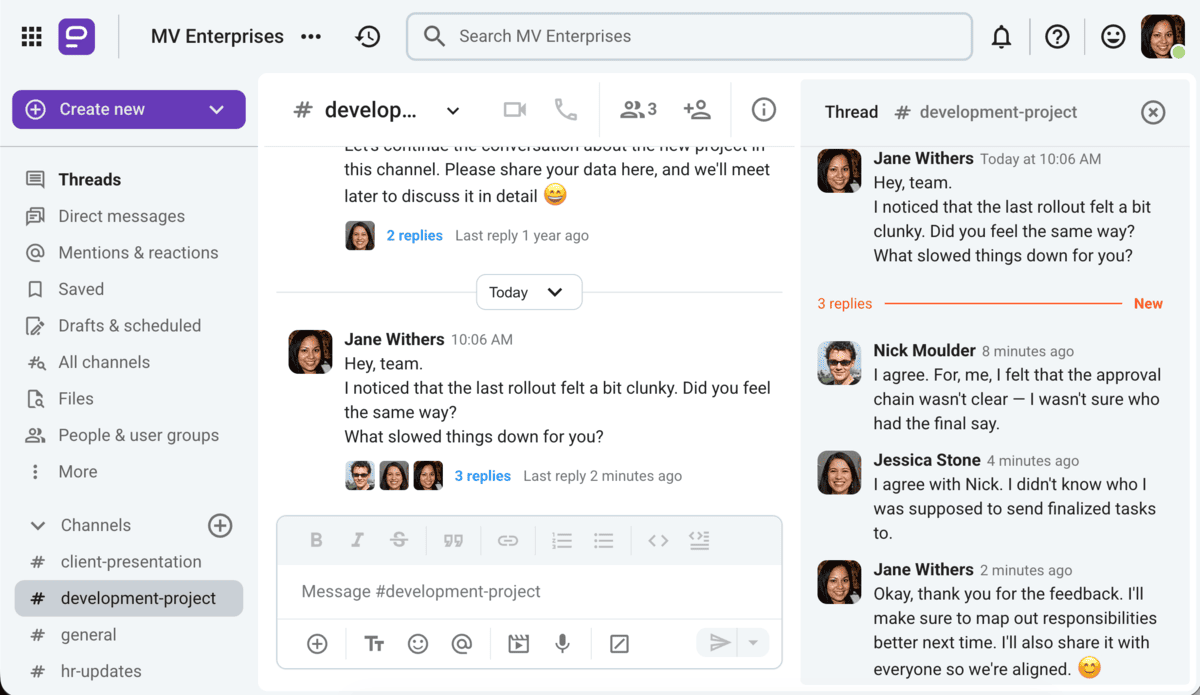
Without that last step, feedback feels like shouting into the void, not a constructive two-way conversation.
Regular check-ins, surveys, and team meetings help open doors for transparent and constructive feedback, but the real test is how responsive leadership is.
When employees see that their input shapes decisions, they become more invested in outcomes and more willing to be open and transparent.
Feedback keeps transparency alive — but only when done right.
Enable clear feedback loops with Pumble
💡 Pumble Pro Tip
Effective downward communication doesn’t come easily to many people. As a leader, it’s a skill you need to practice. To learn how, check out our blog post:
#7 Confront difficult situations, don’t avoid them
Avoiding hard conversations is one of the fastest ways to break trust.
Transparency means facing problems directly — whether it’s:
- Tension between team members,
- Missed deadlines, or
- Performance concerns.
When you address issues head on, they stay manageable and don’t spiral into resentment or confusion. The goal isn’t to assign blame, but to bring problems to the surface and work toward solutions.
Confronting difficult situations in a transparent way requires:
- Empathy,
- Assertiveness, and
- A willingness to be uncomfortable.
As a leader, you should model this by approaching difficult topics with respect and honesty, and by encouraging others to do the same.
When team members see that difficult conversations lead to resolution, they stop minimizing or hiding their own issues.
💡 Pumble Pro Tip
Communication can be challenging even if there are no interpersonal issues or tough conversations. For solutions on how to overcome some common communication challenges, check out our blog post:
#8 Don’t go overboard — avoid the transparency trap
There is such a thing as going overboard when it comes to transparency in communication.
Oversharing can cause resentment, privacy violations, and mistrust — especially if you share information that should never be made public, such as:
- Personal details about individuals,
- Performance issues, or
- Unfiltered data that can be traced back to someone.
Context matters too — raw data without explanation could easily be misinterpreted and lead to false conclusions.
The goal of transparent communication isn’t to expose everything — it’s to share information that is helpful, productive, and helps people do their work better.
To help you decide whether something is appropriate and necessary to share, you can ask yourself: “Does this information help my team, does it hurt anyone, or does it just add noise?”
On top of being honest and transparent, you need to be responsible.
💡 Pumble Pro Tip
Transparent communication urges you to communicate more and express your opinions freely. However, more isn’t necessarily better when it comes to communicating. To find out why, along with more communication myths, check out our blog post:
#9 Share real-time updates
Transparency isn’t only about sharing the final decision — you should also be transparent about the processes that take place before a decision is made.
When you share updates in real time, you give employees context, not just outcomes.
The key, however, is to share the appropriate information with the appropriate people. Not everyone needs to know every detail, but those affected by a choice should never be the last ones to know.
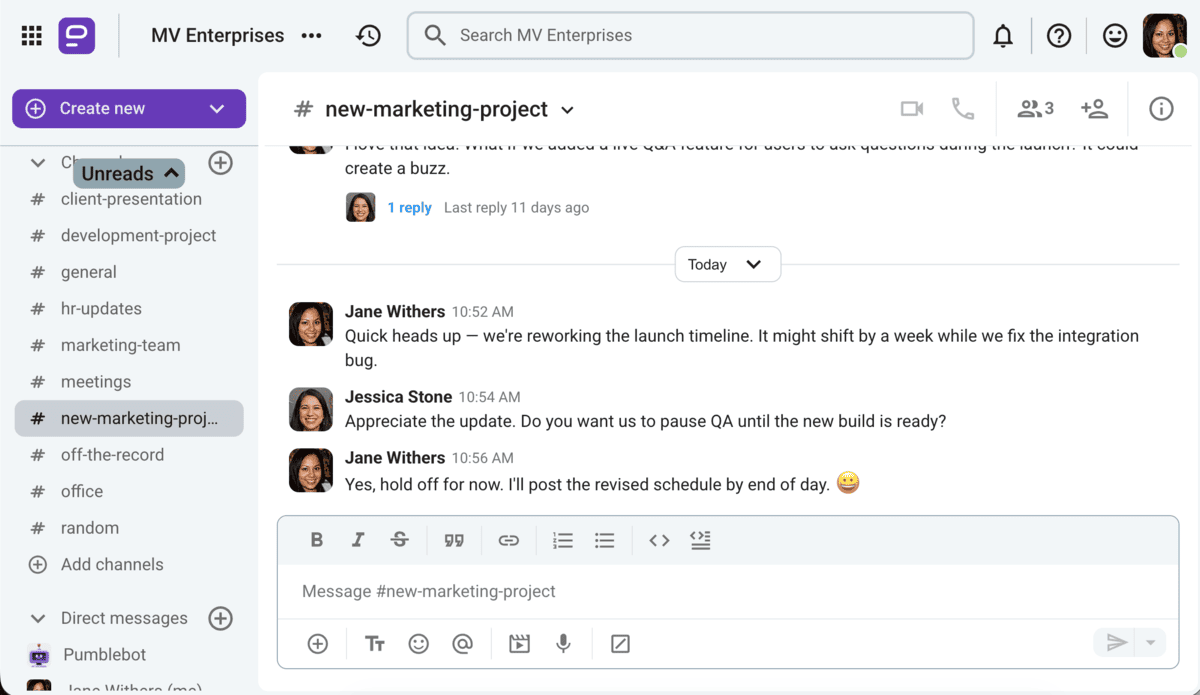
Timely and relevant updates:
- Help prevent rumors,
- Ensure alignment, and
- Allow for valuable input before it’s too late to adjust.
Encourage real-time communication with Pumble
#10 Make information easily accessible
Transparency fails when information is technically shared, but practically impossible to access.
Buried documents or messy email threads that take hours to track down and weed through aren’t exactly helpful or easily accessible.
If you want truly transparent communication, the right information needs to be easy to find, understand, and act on. For this, you need to have reliable tools, with features that support open communication.
Make information easily accessible with Pumble
The right infrastructure for trust — how your tools can help
Using the right tools for corporate communication can help you build and maintain healthy communication practices in your team.
Traditional communication tools such as email create information silos and obstruct productive and transparent communication.
Modern collaboration tools are built to break down information silos, giving teams visibility, context, and easy access to information.
That’s where Pumble comes in.
Pumble is a team communication and collaboration tool that supports open and transparent communication.
Let’s see exactly how Pumble can help you maintain transparency.
Defaulting to open communication with public channels
In a transparent workplace, conversations shouldn’t only happen in private inboxes.
Pumble’s public-by-default channels make transparency the standard — updates, questions, and decisions stay visible to anyone who needs them.
For example, a marketing team can share campaign updates in an open channel where product and sales teams can follow progress and add input in real time. No need for sync meetings and repeated briefings — just one shared space where everyone can access needed information.
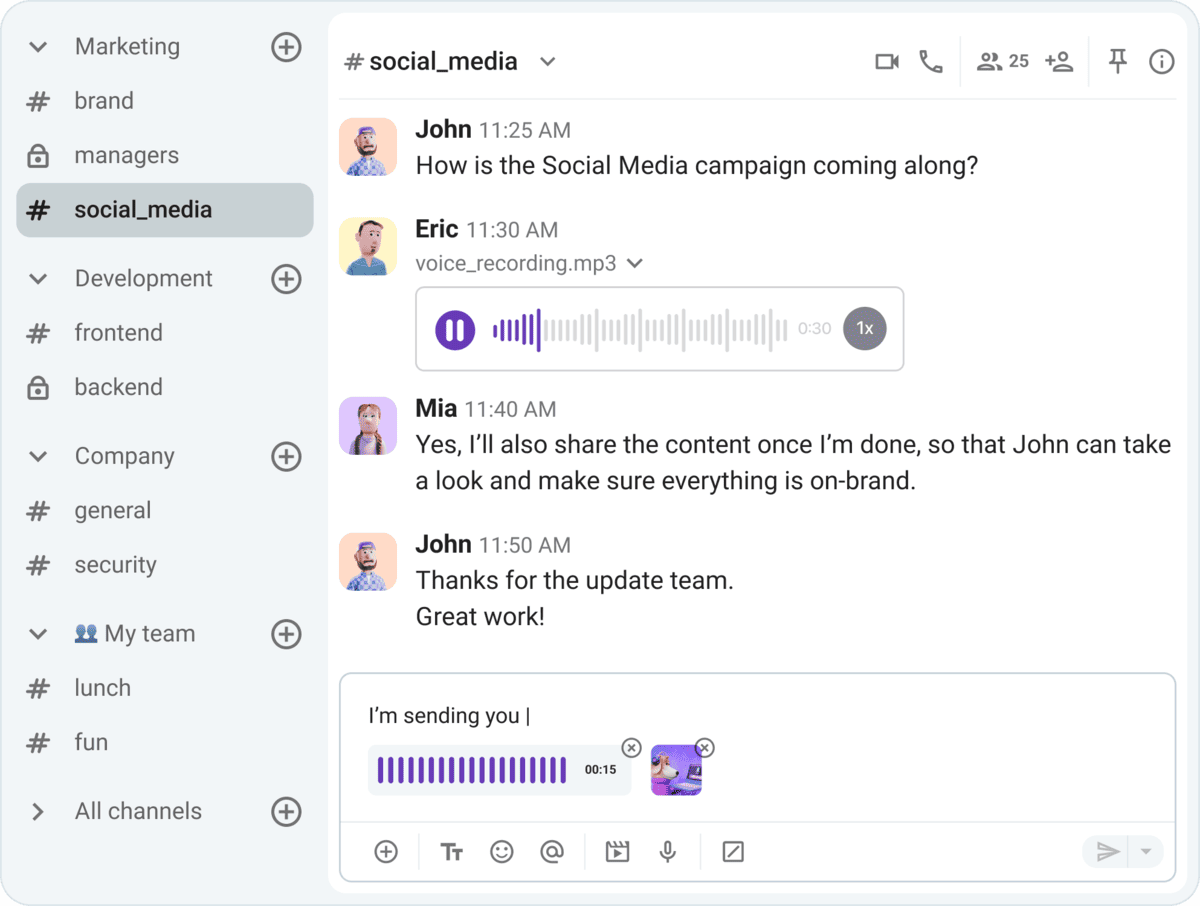
When project updates and discussions happen in open, public spaces, everyone has access to the same information.
This visibility kills the rumor mill and breaks down departmental walls and information silos, ensuring a flow of information across teams.
Open channels encourage transparency and participation, and make decisions easily traceable.
Create transparent communication channels with Pumble
Creating a transparent record with unlimited message history
As we’ve previously discussed, to have a truly transparent company culture, you need to make sure all relevant information is easily accessible to anyone who needs it.
That’s why Pumble’s unlimited message history is the ultimate tool for transparency — it turns every conversation into a permanent record of decisions and context.
For example, when a team member joins a project midway through, they can scroll back and see exactly how and why choices were made, and a detailed history of the project.
This prevents ambiguity and lost information — with Pumble’s unlimited history, you can always search through all past discussions, links, and media.
Get unlimited message history for free with Pumble
Transparent feedback loops with threads
Transparency isn’t just about broadcasting information — it’s also about keeping conversations open after information is shared.
In Pumble, threaded conversations are powerful tools for giving, tracking, and acting on feedback.
For example, after a manager posts a project update, a team member can ask for clarification or add valuable input right under the message, and the manager can respond for everyone to see.

Pumble’s threads keep discussions on-topic and organized by enabling team members to ask contextual questions or give specific feedback directly under announcements or updates.
Transparent communication — powered by Pumble
Transparent communication in the workplace doesn’t come naturally — it’s a skill that needs to be learned and nurtured.
However, with the right tools, it becomes much easier to implement and foster a culture of transparency.
Ready to experience a transparent work culture?






